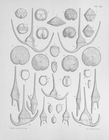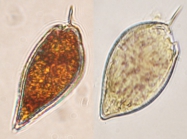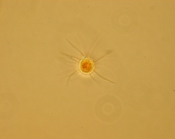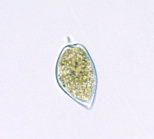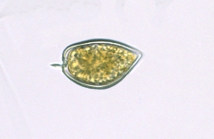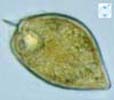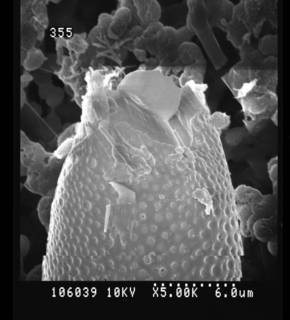WoRMS taxon details
Prorocentrum micans Ehrenberg, 1834
110303 (urn:lsid:marinespecies.org:taxname:110303)
accepted
Species
Prorocentrum levantinoides Bursa, 1959 · unaccepted (synonym)
Prorocentrum levantoides Bursa, 1959 · unaccepted (synonym)
Prorocentrum pacificum Wood, 1963 · unaccepted (synonym)
Prorocentrum schillerii Böhrn, 1933 · unaccepted
marine, brackish, fresh, terrestrial
Ehrenberg, C.G. (1834). Dritter Beitrag zur Erkenntniss grosser Organisation in der Richtung des kleinsten Raumes. <em>Abhandlungen der Königlichen Akademie der Wissenschaften zu Berlin.</em> 1833: 145-336, pls I-XIII [1-11]. [details] 
LSID urn:lsid:algaebase.org:taxname:47384
Distribution neritic and estuarine, sometime oceanic; cosmopolitan in cold temperate to tropical waters. Sometimes forming blooms. Often...
LSID urn:lsid:algaebase.org:taxname:47384 [details]
Distribution neritic and estuarine, sometime oceanic; cosmopolitan in cold temperate to tropical waters. Sometimes forming blooms. Often...
Distribution neritic and estuarine, sometime oceanic; cosmopolitan in cold temperate to tropical waters. Sometimes forming blooms. Often more abundant in late summer-fall [details]
Guiry, M.D. & Guiry, G.M. (2025). AlgaeBase. World-wide electronic publication, National University of Ireland, Galway (taxonomic information republished from AlgaeBase with permission of M.D. Guiry). Prorocentrum micans Ehrenberg, 1834. Accessed through: World Register of Marine Species at: https://www.marinespecies.org/aphia.php?p=taxdetails&id=110303 on 2025-04-11
Date
action
by
2015-06-26 12:00:51Z
changed
db_admin
Copyright notice: the information originating from AlgaeBase may not be downloaded or replicated by any means, without the written permission of the copyright owner (generally AlgaeBase). Fair usage of data in scientific publications is permitted.
Nomenclature
original description
Ehrenberg, C.G. (1834). Dritter Beitrag zur Erkenntniss grosser Organisation in der Richtung des kleinsten Raumes. <em>Abhandlungen der Königlichen Akademie der Wissenschaften zu Berlin.</em> 1833: 145-336, pls I-XIII [1-11]. [details] 
basis of record Gómez, F. (2005). A list of free-living dinoflagellate species in the world's oceans. <em>Acta Bot. Croat.</em> 64(1): 129-212. [details]
basis of record Gómez, F. (2005). A list of free-living dinoflagellate species in the world's oceans. <em>Acta Bot. Croat.</em> 64(1): 129-212. [details]
Ecology
ecology source
Jeong, H.; Yoo, Y.; Park, J.; Song, J.; Kim, S.; Lee, S.; Kim, K.; Yih, W. (2005). Feeding by phototrophic red-tide dinoflagellates: five species newly revealed and six species previously known to be mixotrophic. <em>Aquatic Microbial Ecology.</em> 40: 133-150., available online at https://doi.org/10.3354/ame040133 [details]
ecology source Leles, S. G.; Mitra, A.; Flynn, K. J.; Tillmann, U.; Stoecker, D.; Jeong, H. J.; Burkholder, J.; Hansen, P. J.; Caron, D. A.; Glibert, P. M.; Hallegraeff, G.; Raven, J. A.; Sanders, R. W.; Zubkov, M. (2019). Sampling bias misrepresents the biogeographical significance of constitutive mixotrophs across global oceans. <em>Global Ecology and Biogeography.</em> 28(4): 418-428., available online at https://doi.org/10.1111/geb.12853 [details] Available for editors [request]
[request]
ecology source Mitra, A.; Caron, D. A.; Faure, E.; Flynn, K. J.; Leles, S. G.; Hansen, P. J.; McManus, G. B.; Not, F.; Do Rosario Gomes, H.; Santoferrara, L. F.; Stoecker, D. K.; Tillmann, U. (2023). The Mixoplankton Database (MDB): Diversity of photo‐phago‐trophic plankton in form, function, and distribution across the global ocean. <em>Journal of Eukaryotic Microbiology.</em> 70(4)., available online at https://doi.org/10.1111/jeu.12972 [details]
ecology source Du Yoo, Y.; Jeong, H. J.; Kim, M. S.; Kang, N. S.; Song, J. Y.; Shin, W.; Kim, K. Y.; Lee, K. (2009). Feeding by Phototrophic Red-Tide Dinoflagellates on the Ubiquitous Marine Diatom<i>Skeletonema costatum</i>. <em>Journal of Eukaryotic Microbiology.</em> 56(5): 413-420., available online at https://doi.org/10.1111/j.1550-7408.2009.00421.x [details]
ecology source Jacobson, D.M.; Anderson, D.M. (1996). Widespread phagocytosis of ciliates and other protists by marine mixotrophic and heterotrophic thecate dinoflagellates. <em>J. Phycol.</em> 32: 279–285. [details]
ecology source Leles, S. G.; Mitra, A.; Flynn, K. J.; Tillmann, U.; Stoecker, D.; Jeong, H. J.; Burkholder, J.; Hansen, P. J.; Caron, D. A.; Glibert, P. M.; Hallegraeff, G.; Raven, J. A.; Sanders, R. W.; Zubkov, M. (2019). Sampling bias misrepresents the biogeographical significance of constitutive mixotrophs across global oceans. <em>Global Ecology and Biogeography.</em> 28(4): 418-428., available online at https://doi.org/10.1111/geb.12853 [details] Available for editors
ecology source Mitra, A.; Caron, D. A.; Faure, E.; Flynn, K. J.; Leles, S. G.; Hansen, P. J.; McManus, G. B.; Not, F.; Do Rosario Gomes, H.; Santoferrara, L. F.; Stoecker, D. K.; Tillmann, U. (2023). The Mixoplankton Database (MDB): Diversity of photo‐phago‐trophic plankton in form, function, and distribution across the global ocean. <em>Journal of Eukaryotic Microbiology.</em> 70(4)., available online at https://doi.org/10.1111/jeu.12972 [details]
ecology source Du Yoo, Y.; Jeong, H. J.; Kim, M. S.; Kang, N. S.; Song, J. Y.; Shin, W.; Kim, K. Y.; Lee, K. (2009). Feeding by Phototrophic Red-Tide Dinoflagellates on the Ubiquitous Marine Diatom<i>Skeletonema costatum</i>. <em>Journal of Eukaryotic Microbiology.</em> 56(5): 413-420., available online at https://doi.org/10.1111/j.1550-7408.2009.00421.x [details]
ecology source Jacobson, D.M.; Anderson, D.M. (1996). Widespread phagocytosis of ciliates and other protists by marine mixotrophic and heterotrophic thecate dinoflagellates. <em>J. Phycol.</em> 32: 279–285. [details]
Other
context source (Deepsea)
Intergovernmental Oceanographic Commission (IOC) of UNESCO. The Ocean Biogeographic Information System (OBIS), available online at http://www.iobis.org/ [details]
context source (HKRMS) Lam CWY. & Ho KC. (1988). Phytoplankton characteristics of Tolo Harbour. In: Morton B, editor. Asian Marine Biology 6. pp 5-18. Hong Kong University Press, Hong Kong. [details]
context source (Schelde) Maris, T., O. Beauchard, S. Van Damme, E. Van den Bergh, S. Wijnhoven & P. Meire. (2013). Referentiematrices en Ecotoopoppervlaktes Annex bij de Evaluatiemethodiek Schelde-estuarium Studie naar “Ecotoopoppervlaktes en intactness index”. [Reference matrices and Ecotope areas Annex to the Evaluation methodology Scheldt estuary Study on “Ecotope areas and intactness index”. <em>Monitor Taskforce Publication Series, 2013-01. NIOZ: Yerseke.</em> 35 pp. (look up in IMIS) [details]
context source (Bermuda) Wailes, G. H. (1936). Plankton of the Bermuda oceanographic expeditions. II. Notes on Protozoa. (Plates I & II) . Zoologica Scientific Contributions of the New York Zoological Society , The Society The Zoological Park, New York, 21(5): 81-84 [details]
additional source Muller, Y. (2004). Faune et flore du littoral du Nord, du Pas-de-Calais et de la Belgique: inventaire. [Coastal fauna and flora of the Nord, Pas-de-Calais and Belgium: inventory]. <em>Commission Régionale de Biologie Région Nord Pas-de-Calais: France.</em> 307 pp., available online at http://www.vliz.be/imisdocs/publications/145561.pdf [details]
additional source Meunier, A. (1919). Microplankton de la Mer Flamande: 3. Les Péridiniens. Mémoires du Musée Royal d'Histoire Naturelle de Belgique = Verhandelingen van het Koninklijk Natuurhistorisch Museum van België, VIII(1). Hayez, imprimeur de l'Académie royale de Belgique: Bruxelles. 111, 7 plates pp. (look up in IMIS) [details]
additional source Steidinger, K. A., M. A. Faust, and D. U. Hernández-Becerril. 2009. Dinoflagellates (Dinoflagellata) of the Gulf of Mexico, Pp. 131–154 in Felder, D.L. and D.K. Camp (eds.), Gulf of Mexico–Origins, Waters, and Biota. Biodiversity. Texas A&M Press, College [details]
additional source Liu, J.Y. [Ruiyu] (ed.). (2008). Checklist of marine biota of China seas. <em>China Science Press.</em> 1267 pp. (look up in IMIS) [details] Available for editors [request]
[request]
additional source Lakkis, S. (2011). Le phytoplancton marin du Liban (Méditerranée orientale): biologie, biodiversité, biogéographie. Aracne: Roma. ISBN 978-88-548-4243-4. 293 pp. (look up in IMIS) [details]
additional source Chang, F.H.; Charleston, W.A.G.; McKenna, P.B.; Clowes, C.D.; Wilson, G.J.; Broady, P.A. (2012). Phylum Myzozoa: dinoflagellates, perkinsids, ellobiopsids, sporozoans, in: Gordon, D.P. (Ed.) (2012). New Zealand inventory of biodiversity: 3. Kingdoms Bacteria, Protozoa, Chromista, Plantae, Fungi. pp. 175-216. [details]
additional source Steidinger, K.A.; Tangen, K. (1997). Dinoflagellates. pp. 387-584. In: C.R. Tomas (ed.) (1997). Identifying Marine Phytoplankton. Academic Press: San Diego, CA [etc.] (USA). ISBN 0-12-693018-X. XV, 858 pp., available online at http://www.sciencedirect.com/science/article/pii/B9780126930184500057 [details]
additional source Abé, T.H. (1967). The armoured Dinoflagellata: II. Prorocentridae and Dinophysidae (A). <em>Publications of the Seto Marine Biological Laboratory.</em> 14(5): 369-389. [details] Available for editors [request]
[request]
additional source Campbell, P.H. (1973). Studies on brackish water phytoplankton. UNC.SG.73.07. pp. 1-406. Chapel Hill: Sea Grant Publications, University of North Carolina. [details] Available for editors [request]
[request]
additional source Guiry, M.D. & Guiry, G.M. (2025). AlgaeBase. <em>World-wide electronic publication, National University of Ireland, Galway.</em> searched on YYYY-MM-DD., available online at http://www.algaebase.org [details]
additional source Integrated Taxonomic Information System (ITIS). , available online at http://www.itis.gov [details]
additional source Tomas, C.R. (Ed.). (1997). Identifying marine phytoplankton. Academic Press: San Diego, CA [etc.] (USA). ISBN 0-12-693018-X. XV, 858 pp., available online at http://www.sciencedirect.com/science/book/9780126930184 [details]
additional source Brandt, S. (2001). Dinoflagellates, <B><I>in</I></B>: Costello, M.J. <i>et al.</i> (Ed.) (2001). <i>European register of marine species: a check-list of the marine species in Europe and a bibliography of guides to their identification. Collection Patrimoines Naturels,</i> 50: pp. 47-53 (look up in IMIS) [details]
additional source Horner, R. A. (2002). A taxonomic guide to some common marine phytoplankton. <em>Biopress Ltd. Bristol.</em> 1-195. [details]
additional source Martin, J. L.; LeGresley, M. M. ; Strain, P. M. (2001). Phytoplankton monitoring in the Western Isles region of the Bay of Fundy during 1997-98. <em>Canadian Technical Report of Fisheries and Aquatic Sciences 2349.</em> 4: 1-85. [details]
context source (HKRMS) Lam CWY. & Ho KC. (1988). Phytoplankton characteristics of Tolo Harbour. In: Morton B, editor. Asian Marine Biology 6. pp 5-18. Hong Kong University Press, Hong Kong. [details]
context source (Schelde) Maris, T., O. Beauchard, S. Van Damme, E. Van den Bergh, S. Wijnhoven & P. Meire. (2013). Referentiematrices en Ecotoopoppervlaktes Annex bij de Evaluatiemethodiek Schelde-estuarium Studie naar “Ecotoopoppervlaktes en intactness index”. [Reference matrices and Ecotope areas Annex to the Evaluation methodology Scheldt estuary Study on “Ecotope areas and intactness index”. <em>Monitor Taskforce Publication Series, 2013-01. NIOZ: Yerseke.</em> 35 pp. (look up in IMIS) [details]
context source (Bermuda) Wailes, G. H. (1936). Plankton of the Bermuda oceanographic expeditions. II. Notes on Protozoa. (Plates I & II) . Zoologica Scientific Contributions of the New York Zoological Society , The Society The Zoological Park, New York, 21(5): 81-84 [details]
additional source Muller, Y. (2004). Faune et flore du littoral du Nord, du Pas-de-Calais et de la Belgique: inventaire. [Coastal fauna and flora of the Nord, Pas-de-Calais and Belgium: inventory]. <em>Commission Régionale de Biologie Région Nord Pas-de-Calais: France.</em> 307 pp., available online at http://www.vliz.be/imisdocs/publications/145561.pdf [details]
additional source Meunier, A. (1919). Microplankton de la Mer Flamande: 3. Les Péridiniens. Mémoires du Musée Royal d'Histoire Naturelle de Belgique = Verhandelingen van het Koninklijk Natuurhistorisch Museum van België, VIII(1). Hayez, imprimeur de l'Académie royale de Belgique: Bruxelles. 111, 7 plates pp. (look up in IMIS) [details]
additional source Steidinger, K. A., M. A. Faust, and D. U. Hernández-Becerril. 2009. Dinoflagellates (Dinoflagellata) of the Gulf of Mexico, Pp. 131–154 in Felder, D.L. and D.K. Camp (eds.), Gulf of Mexico–Origins, Waters, and Biota. Biodiversity. Texas A&M Press, College [details]
additional source Liu, J.Y. [Ruiyu] (ed.). (2008). Checklist of marine biota of China seas. <em>China Science Press.</em> 1267 pp. (look up in IMIS) [details] Available for editors
additional source Lakkis, S. (2011). Le phytoplancton marin du Liban (Méditerranée orientale): biologie, biodiversité, biogéographie. Aracne: Roma. ISBN 978-88-548-4243-4. 293 pp. (look up in IMIS) [details]
additional source Chang, F.H.; Charleston, W.A.G.; McKenna, P.B.; Clowes, C.D.; Wilson, G.J.; Broady, P.A. (2012). Phylum Myzozoa: dinoflagellates, perkinsids, ellobiopsids, sporozoans, in: Gordon, D.P. (Ed.) (2012). New Zealand inventory of biodiversity: 3. Kingdoms Bacteria, Protozoa, Chromista, Plantae, Fungi. pp. 175-216. [details]
additional source Steidinger, K.A.; Tangen, K. (1997). Dinoflagellates. pp. 387-584. In: C.R. Tomas (ed.) (1997). Identifying Marine Phytoplankton. Academic Press: San Diego, CA [etc.] (USA). ISBN 0-12-693018-X. XV, 858 pp., available online at http://www.sciencedirect.com/science/article/pii/B9780126930184500057 [details]
additional source Abé, T.H. (1967). The armoured Dinoflagellata: II. Prorocentridae and Dinophysidae (A). <em>Publications of the Seto Marine Biological Laboratory.</em> 14(5): 369-389. [details] Available for editors
additional source Campbell, P.H. (1973). Studies on brackish water phytoplankton. UNC.SG.73.07. pp. 1-406. Chapel Hill: Sea Grant Publications, University of North Carolina. [details] Available for editors
additional source Guiry, M.D. & Guiry, G.M. (2025). AlgaeBase. <em>World-wide electronic publication, National University of Ireland, Galway.</em> searched on YYYY-MM-DD., available online at http://www.algaebase.org [details]
additional source Integrated Taxonomic Information System (ITIS). , available online at http://www.itis.gov [details]
additional source Tomas, C.R. (Ed.). (1997). Identifying marine phytoplankton. Academic Press: San Diego, CA [etc.] (USA). ISBN 0-12-693018-X. XV, 858 pp., available online at http://www.sciencedirect.com/science/book/9780126930184 [details]
additional source Brandt, S. (2001). Dinoflagellates, <B><I>in</I></B>: Costello, M.J. <i>et al.</i> (Ed.) (2001). <i>European register of marine species: a check-list of the marine species in Europe and a bibliography of guides to their identification. Collection Patrimoines Naturels,</i> 50: pp. 47-53 (look up in IMIS) [details]
additional source Horner, R. A. (2002). A taxonomic guide to some common marine phytoplankton. <em>Biopress Ltd. Bristol.</em> 1-195. [details]
additional source Martin, J. L.; LeGresley, M. M. ; Strain, P. M. (2001). Phytoplankton monitoring in the Western Isles region of the Bay of Fundy during 1997-98. <em>Canadian Technical Report of Fisheries and Aquatic Sciences 2349.</em> 4: 1-85. [details]
 Present
Present  Present in aphia/obis/gbif/idigbio
Present in aphia/obis/gbif/idigbio  Inaccurate
Inaccurate  Introduced: alien
Introduced: alien  Containing type locality
Containing type locality
From editor or global species database
LSID urn:lsid:algaebase.org:taxname:47384 [details]From regional or thematic species database
Harmful effect Non-toxigenic marine microalgal species associated with animal kills or health impairment. [details]Harmful effect This species has previously been considered to be toxic, but there is presently no evidence for this [details]
Importance General: known for producing "red tides" because the cells are so abundant they make water change color. [details]
Unreviewed
Diet general for group: both heterotrophic (eat other organisms) and autotrophic (photosynthetic) [details]Distribution neritic and estuarine, sometime oceanic; cosmopolitan in cold temperate to tropical waters. Sometimes forming blooms. Often more abundant in late summer-fall [details]
Habitat pelagic [details]
Predators marine microorganisms and animal larvae [details]
Reproduction general for group: both sexual and asexual [details]
| Language | Name | |
|---|---|---|
| Japanese | ツノフタヒゲムシ | [details] |
PlanktonNet Image
Published in AlgaeBase
Published in AlgaeBase (from synonym Prorocentrum schillerii Böhrn, 1933)
(from synonym Prorocentrum schillerii Böhrn, 1933)
Published in AlgaeBase (from synonym Prorocentrum pacificum Wood, 1963)
(from synonym Prorocentrum pacificum Wood, 1963)
Published in AlgaeBase (from synonym Prorocentrum levantinoides Bursa, 1959)
(from synonym Prorocentrum levantinoides Bursa, 1959)
To Barcode of Life (21 barcodes)
To Biodiversity Heritage Library (1 publication) (from synonym Prorocentrum pacificum Wood, 1963)
To Biodiversity Heritage Library (179 publications)
To Biodiversity Heritage Library (2 publications) (from synonym Prorocentrum levantinoides Bursa, 1959)
To Biological Information System for Marine Life (BISMaL)
To Dyntaxa
To European Nucleotide Archive, ENA (Prorocentrum micans)
To GenBank (18856 nucleotides; 2527 proteins)
To NMNH Extant Collection (106035.jpg)
To NMNH Extant Collection (106039.jpg)
To PESI
To PESI (from synonym Prorocentrum schillerii Böhrn, 1933)
To ITIS
Published in AlgaeBase

Published in AlgaeBase
 (from synonym Prorocentrum schillerii Böhrn, 1933)
(from synonym Prorocentrum schillerii Böhrn, 1933)Published in AlgaeBase
 (from synonym Prorocentrum pacificum Wood, 1963)
(from synonym Prorocentrum pacificum Wood, 1963)Published in AlgaeBase
 (from synonym Prorocentrum levantinoides Bursa, 1959)
(from synonym Prorocentrum levantinoides Bursa, 1959)To Barcode of Life (21 barcodes)
To Biodiversity Heritage Library (1 publication) (from synonym Prorocentrum pacificum Wood, 1963)
To Biodiversity Heritage Library (179 publications)
To Biodiversity Heritage Library (2 publications) (from synonym Prorocentrum levantinoides Bursa, 1959)
To Biological Information System for Marine Life (BISMaL)
To Dyntaxa
To European Nucleotide Archive, ENA (Prorocentrum micans)
To GenBank (18856 nucleotides; 2527 proteins)
To NMNH Extant Collection (106035.jpg)
To NMNH Extant Collection (106039.jpg)
To PESI
To PESI (from synonym Prorocentrum schillerii Böhrn, 1933)
To ITIS

